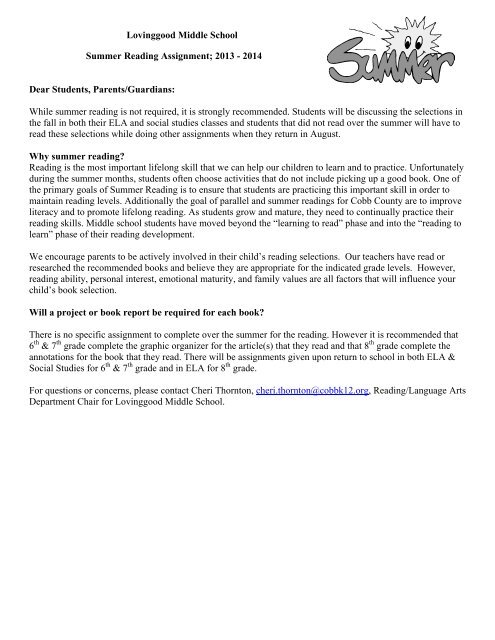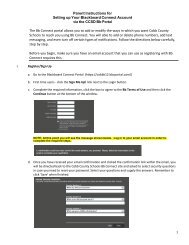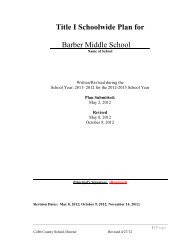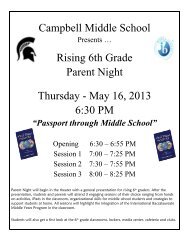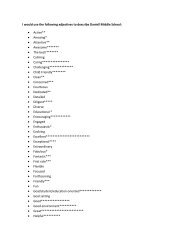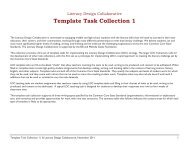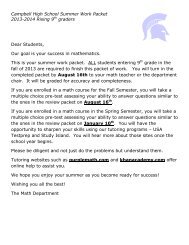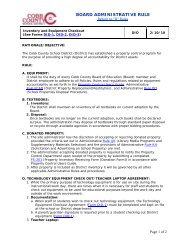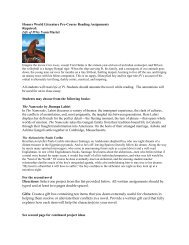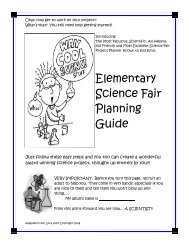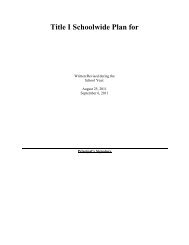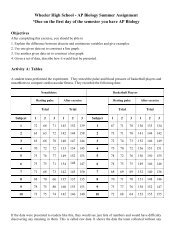Summer Reading Program - Cobb County School District
Summer Reading Program - Cobb County School District
Summer Reading Program - Cobb County School District
You also want an ePaper? Increase the reach of your titles
YUMPU automatically turns print PDFs into web optimized ePapers that Google loves.
Lovinggood Middle <strong>School</strong><br />
<strong>Summer</strong> <strong>Reading</strong> Assignment; 2013 - 2014<br />
Dear Students, Parents/Guardians:<br />
While summer reading is not required, it is strongly recommended. Students will be discussing the selections in<br />
the fall in both their ELA and social studies classes and students that did not read over the summer will have to<br />
read these selections while doing other assignments when they return in August.<br />
Why summer reading?<br />
<strong>Reading</strong> is the most important lifelong skill that we can help our children to learn and to practice. Unfortunately<br />
during the summer months, students often choose activities that do not include picking up a good book. One of<br />
the primary goals of <strong>Summer</strong> <strong>Reading</strong> is to ensure that students are practicing this important skill in order to<br />
maintain reading levels. Additionally the goal of parallel and summer readings for <strong>Cobb</strong> <strong>County</strong> are to improve<br />
literacy and to promote lifelong reading. As students grow and mature, they need to continually practice their<br />
reading skills. Middle school students have moved beyond the “learning to read” phase and into the “reading to<br />
learn” phase of their reading development.<br />
We encourage parents to be actively involved in their child’s reading selections. Our teachers have read or<br />
researched the recommended books and believe they are appropriate for the indicated grade levels. However,<br />
reading ability, personal interest, emotional maturity, and family values are all factors that will influence your<br />
child’s book selection.<br />
Will a project or book report be required for each book?<br />
There is no specific assignment to complete over the summer for the reading. However it is recommended that<br />
6 th & 7 th grade complete the graphic organizer for the article(s) that they read and that 8 th grade complete the<br />
annotations for the book that they read. There will be assignments given upon return to school in both ELA &<br />
Social Studies for 6 th & 7 th grade and in ELA for 8 th grade.<br />
For questions or concerns, please contact Cheri Thornton, cheri.thornton@cobbk12.org, <strong>Reading</strong>/Language Arts<br />
Department Chair for Lovinggood Middle <strong>School</strong>.
Rising 6th Grade <strong>Summer</strong> <strong>Reading</strong> Choices:<br />
Read one from this list: This will align with your first unit of study in Social Studies in 6 th Grade.<br />
Breaking Stalin’s Nose by Eugene Yelchin<br />
The Unforgotten Coat by Frank Cottrell Boyce<br />
When the Wall Came Down by Serge Schmemann<br />
Truce by Jim Murphy<br />
The Wall: Growing Up Behind the Iron Curtain by Peter Sis<br />
The Shadow Children by Steven Schnur<br />
Rose Blanche by Roberto Innocenti<br />
Also find a news article that aligns with your summer reading selection for the social studies cross-curricular alignment.<br />
Complete an organizer for each of the articles. Be prepared to discuss your cross-curricular summer reading with both<br />
your Social Studies teacher and your Language Arts teacher at the beginning of the year.<br />
Article citation- Use MLA formatting.<br />
What is the issue or event about? Be<br />
specific.<br />
Who is the article about? Be specific.<br />
When did this issue or event occur?<br />
Where did this issue or event occur?<br />
What happened?<br />
How does this issue or event relate to<br />
the fiction book you chose?
Rising 7 th Grade <strong>Summer</strong> <strong>Reading</strong> Choices<br />
Read one from this list: This will align with your first unit of study in Social Studies in 7th Grade.<br />
Sunrise Over Fallujah by Walter Dean Myers<br />
Words in the Dust by Trent Reedy **<br />
** The novel Words in the Dust is in the process of going through re-publication and won’t be released in paperback until September, 2013. It is<br />
available now for immediate download for Kindle (through Amazon) or Nook (through Barnes & Noble) or you may find it used through some on-line<br />
book sellers. There are print copies for check-out through the <strong>Cobb</strong> <strong>County</strong> Public Library System as well.<br />
Additionally, find two current news articles that align with your summer reading fiction selection from above. Complete an<br />
organizer for each article and attach a copy of each article to the organizer. Be prepared to discuss your summer reading with both<br />
your Social Studies teacher and your Language Arts teacher at the beginning of the year.<br />
(You should print one copy of this organizer for each article)<br />
Article citation- Use MLA<br />
formatting.<br />
What is the issue or event about?<br />
Be specific.<br />
Who is the article about? Be<br />
specific.<br />
When did this issue or event<br />
occur?<br />
Where did this issue or event<br />
occur?<br />
What happened?<br />
How does this issue or event relate<br />
to the fiction book you chose?
Rising 8 th Grade <strong>Summer</strong> Readig Choices:<br />
Read a classic literature piece from the list of author’s below. You should annotate and take notes as you read.<br />
You should focus on characterization, theme and symbolism more so than the basic plot. Assignment for this<br />
novel selection will be discussed the first week of school. Parents should help students in the selection of the<br />
novel, as some titles may contain themes unsuitable for your child.<br />
Shakespeare, William<br />
Wells, H. G.<br />
Defoe, Daniel<br />
Dickens, Charles (not Christmas Carol)<br />
Marlowe, Christopher<br />
Wilde, Oscar<br />
Twain, Mark (AC students should not<br />
choose Tom Sawyer or Huck Finn)<br />
London, Jack<br />
Bellamy, Edward<br />
Orwell, George<br />
Austen, Jane<br />
Bronte, Charlotte<br />
Bronte, Emily<br />
Cooper, James Fennimore<br />
Milton, John<br />
Verne, Jules<br />
Dumas, Alexandre<br />
Hemingway, Ernest<br />
Cather, Willa<br />
Salinger, J. D.<br />
Ellison, Ralph<br />
Kipling, Rudyard<br />
Shelley, Mary<br />
Carroll, Lewis<br />
Hawthorne, Nathaniel<br />
Sinclair, Upton<br />
Swift, Jonathan<br />
Hugo, Victor<br />
Faulkner, William<br />
Cervantes, Migel de<br />
Heller, Joseph<br />
Baum, L. Frank<br />
While you read your novel, you should annotate your selection. Directions for annotation are given below.<br />
<br />
Stoker, Bram<br />
Homer<br />
Stowe, Harriet Beecher<br />
Forbes, Esther<br />
Crane, Steven<br />
Alcott, Louisa Mae<br />
Melville, Herman<br />
Montgomery, Lucy Maud<br />
McCullers, Carson<br />
O’Connor, Flannery<br />
Golding, William<br />
Do you want to be able to recall a book that you read weeks or months later? The best way to do that is to be an active reader by<br />
annotating (or making notes in) a text! Annotation is a key component of close reading. In eighth grade we will annotate texts all<br />
year, so as you read this summer begin to work on a system that works for you (within the following guidelines). By annotating<br />
effectively, you can review an entire text in 30 minutes and be prepared for any assessment! Follow the instructions below…<br />
Materials Needed:<br />
<br />
<br />
<br />
<br />
<br />
Yellow highlighter: This color is most preferred because it is the least distracting than other colors and emphasizes the parts<br />
of the text that you want to remember. (You will only need the highlighter if you own your own copy of the text.) If you<br />
don’t own the text, consider using yellow sticky notes in lieu of highlighting.<br />
You may want other colors: when you re-read, use different colors to show additional detail or development of ideas as you<br />
have time to reflect.<br />
Pencil: You need this to write in the text (or on a sticky note if you don’t own the text). Using a pencil is a better choice since<br />
even geniuses need to correct mistakes!<br />
A Dictionary: It is a good idea to keep a dictionary nearby in order to look up words you may not know so that you can<br />
better understand the text.<br />
Your Text: If possible, it is best to have your own copy of the text so that you can highlight and write in it. However, if you<br />
don’t, you need to get some sticky notes that you can use to put in the book and then take out when you return the book.<br />
Before <strong>Reading</strong>: (A caution for you speed readers – close reading & annotation requires a more methodical approach. Slow down so<br />
you can complete the annotation. You can always go back and read it straight through later).<br />
1. Read the front and rear jackets of the book, including information about the author. This can give you a more rounded picture<br />
of the book while reading.<br />
2. Always read the title page, introductions, table of contents, prefaces and any notes from the author. These will help<br />
familiarize yourself with the content of the book and its origins.<br />
3. Check to see if there is a glossary or any other information at the back of the book that you can use while you are reading.<br />
4. Find the right place to read your book. Some people need complete silence while others can read in any environment. Only<br />
you know what your best reading environment is, so find it and use it!<br />
Active <strong>Reading</strong> and Annotation Methods (Please use these for standardization of class instruction):
1. Highlight key information, including vocabulary you don’t understand, significant quotes, references to other literary works,<br />
or any parts of the text relating to themes, significant characters, or events. Close reading means that you are thinking while<br />
reading. Have a conversation with the text. Talk back to it.<br />
2. While you read, use your pencil to make notes in the margins about key material. You can use punctuation marks such as<br />
stars, arrows, question marks, check marks, and brackets to mark the text that you may want to come back to. You should<br />
come up with your own unique system to mark what you think is important or questionable. You should comment on things<br />
that you think are significant, powerful, meaningful – things you agree/disagree with in the text.<br />
3. At the end of each chapter, summarize the main ideas/events in the chapter in one or two sentences. Make note of where plot<br />
events occur (exposition to rising action, climax, falling action, resolution, conclusion).<br />
4. Use the inside front cover of the book to keep a list of important information with page number references in the book. Some<br />
examples of what you could list here are themes, text that connects to the book’s title, important names of characters &<br />
character development, memorable quotes, or key questions you may have about the text. Consider literary elements such as<br />
symbolism, mood, tone, setting, archetypes, and motifs. (If you don’t own the book, do this on a separate piece of paper or on<br />
sticky notes.)<br />
5. Use the inside back cover to make a list of key vocabulary words and definitions from the text. Choose words that are unique<br />
to the author/story/culture or advanced vocabulary. (If you don’t own the book, do this on a separate piece of paper or on<br />
sticky notes.)<br />
6. Additional information you may want to include in margins or on post-it notes may include – any epiphanies that you have<br />
while reading – mark your ah-ha moments; what about word choice (diction or syntax), repetition, figurative elements.<br />
After <strong>Reading</strong>:<br />
1. After you have read the book, you may want to re-read it, or skim it again, adding to your notes and highlighting.<br />
2. Keep all of your notes with the book (if you didn’t write in it) so that you can go back and review it.<br />
3. You may also want to make a list of characters and descriptions for the characters to better help you remember them.<br />
4. If there is a confusing timeline in the book, you may want to create your own timeline on paper to help you understand the<br />
sequence of events. Choose the top ten events from the book and put them in order.<br />
5. When you are done with the book, don’t put it down for a while! Complete any assignments for it and review your notes<br />
before any tests.<br />
Don’t want to buy the book, most classic literature can be found on line in pdf format. Consider using the following web sites to look<br />
for your selection.<br />
http://www.online-literature.com/<br />
http://www.read.gov/books/<br />
http://www.gutenberg.org/<br />
Using an e-reader like Kindle, Nook or i-Pad, check out their annotation software and become familiar with it before you start to read.<br />
If your device has a memory card, consider saving your annotations there or to your cloud so they can be recovered if your device is<br />
lost or damaged.<br />
Information on how to annotate a novel is taken from http://www.collegeboard.com .


